Article Directory
- 1. System Requirements Analysis
- 2. System design
-
- 1. Functional structure design
- 2. Concept design
-
- 2.2.1 bill_food table ER diagram
- 2.2.2 Bills table ER diagram
- 2.2.3 categories ER diagram
- 2.2.4 discounts table ER diagram
- 2.2.5 emp table ER diagram
- 2.2.6 ER diagram of food table
- 2.2.7 ER diagram of member table
- 2.2.8 member_point_bill table ER diagram
- 2.2.9 Servers table ER diagram
- 2.2.10 tables table ER diagram
- 2.2.11 user table ER diagram
- 3. Logical design (table design)
- 3. System implementation (mainly reflected in the following parts)
- 4. Source code acquisition
1. System Requirements Analysis
Needs analysis must first determine the object of research and analysis, here there are two parties to the needs analysis object: buyers and sellers.
For buyers, the demand is to be able to order food online, which can be refined into: being able to obtain food information and order food online. Buyers, as consumers, all want better service experience, and hope to be able to eat dishes that satisfy their own taste through relatively simple and smooth operations. This requires that the system interface can vividly and effectively present the various information of the order, the price of the dishes, the number of tables where you can choose to sit, etc., as well as a simple operation interface when adding meals.
For sellers, the demand is to be able to add, delete, and modify dishes and increase members. Specifically, it can be refined to obtain all dish information online, add dishes, modify dish prices, delete dishes, and add members. Sellers are merchants, and merchants must be able to efficiently obtain such information. Of course, the graphical interface and geometric form of information presentation are the most direct and clear.
2. System design
1. Functional structure design
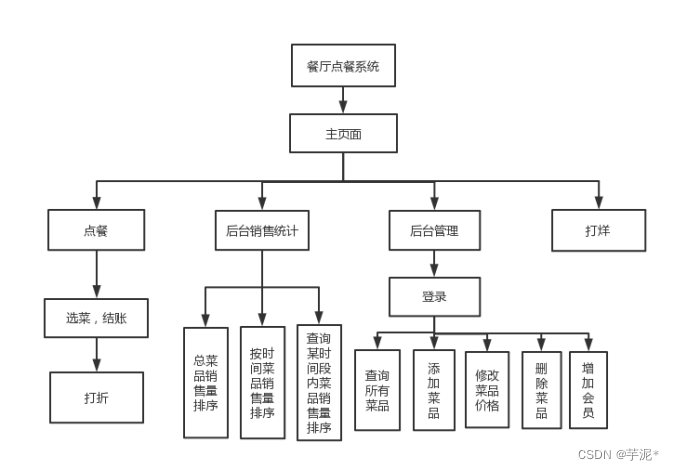
2. Concept design
2.2.1 bill_food table ER diagram
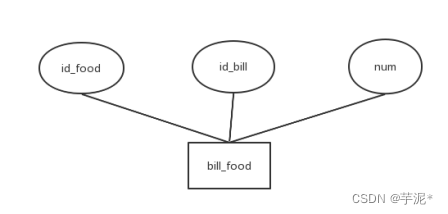
2.2.2 Bills table ER diagram
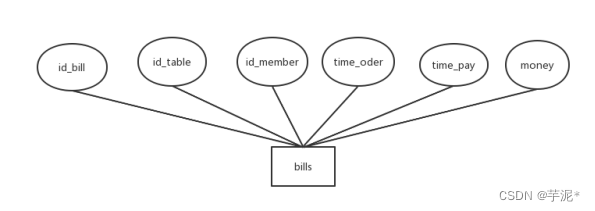
2.2.3 categories ER diagram

2.2.4 discounts table ER diagram

2.2.5 emp table ER diagram

2.2.6 ER diagram of food table
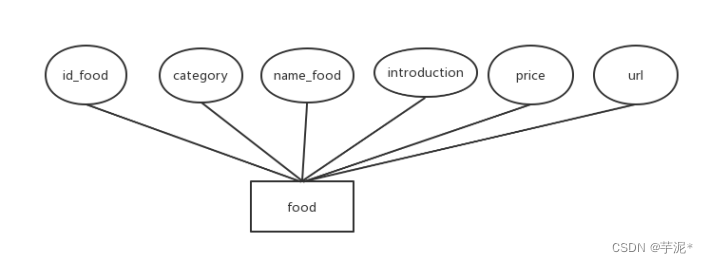
2.2.7 ER diagram of member table
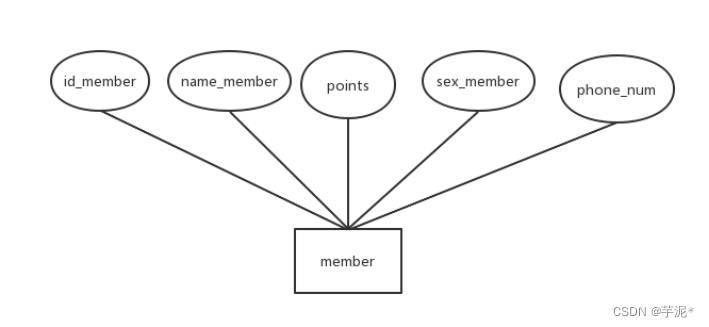
2.2.8 member_point_bill table ER diagram
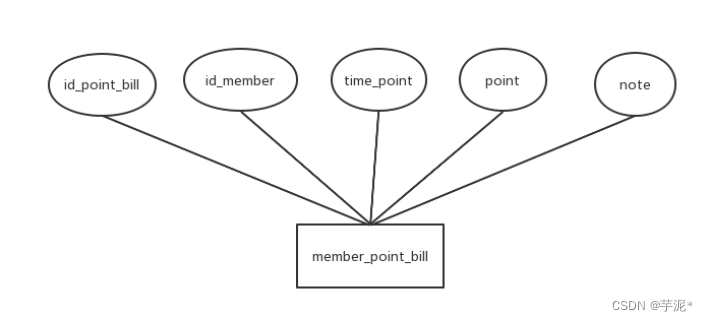
2.2.9 Servers table ER diagram

2.2.10 tables table ER diagram
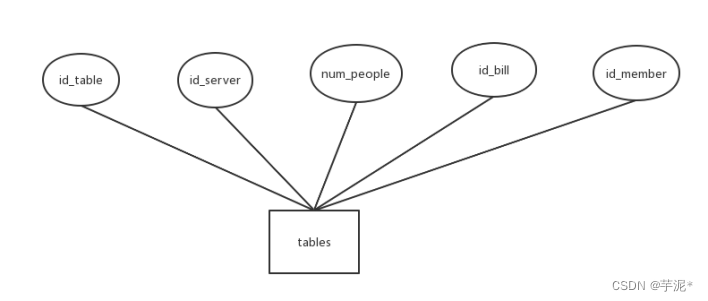
2.2.11 user table ER diagram
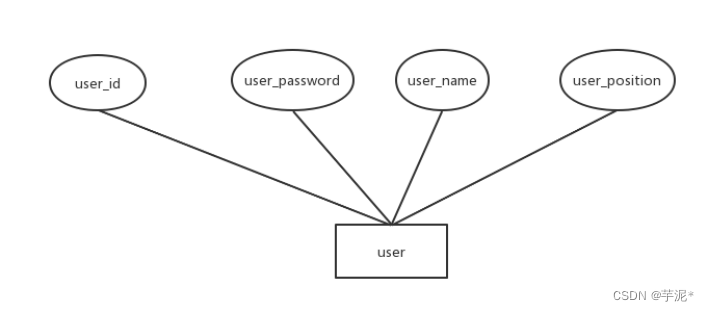
3. Logical design (table design)
①bill_food table
CREATE TABLE `bill_food` (
`id_food` int NOT NULL,
`id_bill` int NOT NULL,
`num` int NOT NULL,
PRIMARY KEY (`id_food`,`id_bill`),
KEY `FK_bill_food2` (`id_bill`),
CONSTRAINT `FK_bill_food` FOREIGN KEY (`id_food`) REFERENCES `food` (`id_food`) ON DELETE RESTRICT ON UPDATE RESTRICT,
CONSTRAINT `FK_bill_food2` FOREIGN KEY (`id_bill`) REFERENCES `bills` (`id_bill`) ON DELETE RESTRICT ON UPDATE RESTRICT
) ;
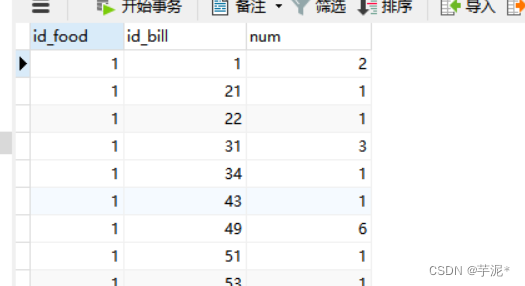
② bills table
CREATE TABLE `bills` (
`id_bill` int NOT NULL,
`id_table` int NOT NULL,
`id_member` int DEFAULT NULL,
`time_order` datetime NOT NULL,
`time_pay` datetime DEFAULT NULL,
`money` int NOT NULL,
PRIMARY KEY (`id_bill`),
KEY `FK_bill_member` (`id_member`),
KEY `FK_table_bill` (`id_table`),
KEY `time_order` (`time_order`),
CONSTRAINT `FK_bill_member` FOREIGN KEY (`id_member`) REFERENCES `member` (`id_member`) ON DELETE RESTRICT ON UPDATE RESTRICT,
CONSTRAINT `FK_table_bill` FOREIGN KEY (`id_table`) REFERENCES `tables` (`id_table`) ON DELETE RESTRICT ON UPDATE RESTRICT
) ;
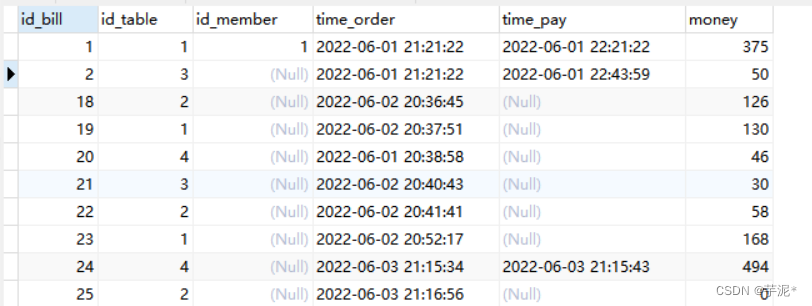
③categories table
CREATE TABLE `categories` (
`category` char(20) NOT NULL,
PRIMARY KEY (`category`)
);
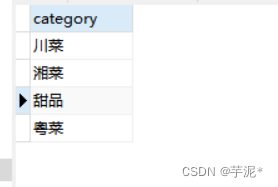
④discounts table
CREATE TABLE `discounts` (
`id_discount` int NOT NULL,
`off_price` int NOT NULL,
`require_points` int NOT NULL,
PRIMARY KEY (`id_discount`)
) ;

⑤ emp table
CREATE TABLE `emp` (
`id_emp` int NOT NULL,
`id_server` int DEFAULT NULL,
`name_emp` char(20) NOT NULL,
`sex_emp` char(1) DEFAULT NULL,
`phone_num` char(11) DEFAULT NULL,
`position` char(20) DEFAULT NULL,
PRIMARY KEY (`id_emp`)
);

⑥ food table
CREATE TABLE `food` (
`id_food` int NOT NULL,
`category` char(20) NOT NULL,
`name_food` char(20) NOT NULL,
`introduction` char(100) DEFAULT NULL,
`price` int NOT NULL,
`url` char(100) DEFAULT NULL,
PRIMARY KEY (`id_food`),
KEY `FK_food_category` (`category`),
CONSTRAINT `FK_food_category` FOREIGN KEY (`category`) REFERENCES `categories` (`category`) ON DELETE RESTRICT ON UPDATE RESTRICT
) ;

⑦member table
CREATE TABLE `member` (
`id_member` int NOT NULL,
`name_member` char(20) DEFAULT NULL,
`points` int NOT NULL,
`sex` char(1) DEFAULT NULL,
`phone_num` char(11) DEFAULT NULL,
PRIMARY KEY (`id_member`)
) ;

⑧member_point_bills table
CREATE TABLE `member_point_bill` (
`id_point_bill` int NOT NULL,
`id_member` int NOT NULL,
`time_point` datetime NOT NULL,
`point` int NOT NULL,
`note` char(20) DEFAULT NULL,
PRIMARY KEY (`id_point_bill`),
KEY `FK_member_point_bill` (`id_member`),
CONSTRAINT `FK_member_point_bill` FOREIGN KEY (`id_member`) REFERENCES `member` (`id_member`) ON DELETE RESTRICT ON UPDATE RESTRICT
) ;

⑨servers table
CREATE TABLE `servers` (
`id_server` int NOT NULL,
`id_emp` int NOT NULL,
PRIMARY KEY (`id_server`),
KEY `FK_to_server` (`id_emp`),
CONSTRAINT `FK_to_server` FOREIGN KEY (`id_emp`) REFERENCES `emp` (`id_emp`) ON DELETE RESTRICT ON UPDATE RESTRICT
) ;
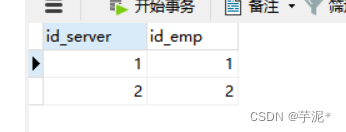
⑩tables table
CREATE TABLE `tables` (
`id_table` int NOT NULL,
`id_server` int NOT NULL,
`num_people` int NOT NULL,
`id_bill` int DEFAULT NULL,
`id_member` int DEFAULT NULL,
PRIMARY KEY (`id_table`),
KEY `FK_server_table` (`id_server`),
CONSTRAINT `FK_server_table` FOREIGN KEY (`id_server`) REFERENCES `servers` (`id_server`) ON DELETE RESTRICT ON UPDATE RESTRICT
) ;
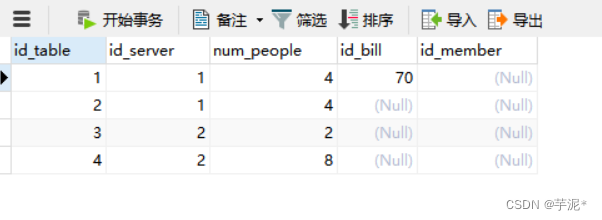
11.user table
CREATE TABLE `user` (
`user_id` varchar(4) CHARACTER SET utf8 COLLATE utf8_general_ci NOT NULL,
`user_password` varchar(255) NOT NULL,
`user_name` varchar(255) DEFAULT NULL,
`user_position` varchar(255) DEFAULT NULL,
PRIMARY KEY (`user_id`)
);

3. System implementation (mainly reflected in the following parts)
1. Techniques, methods and tools adopted by the system
The restaurant ordering system uses the pycharm tkinter library for visualization, and the database management uses MySQL
2. Rendering
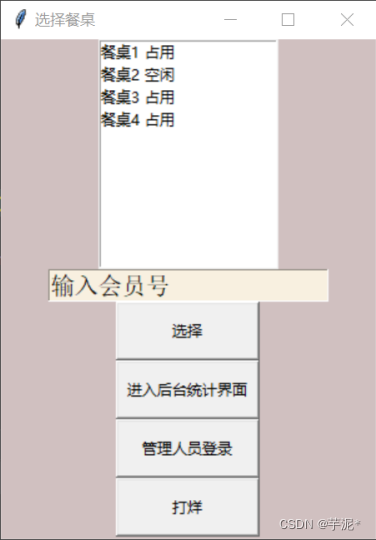
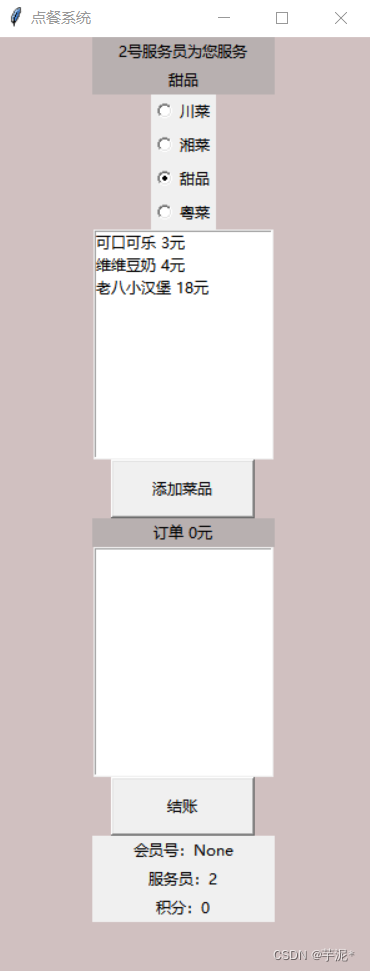
Other pictures will not be shown
3. Implement the code
2.1 main.py
def is_number(s):
try:
float(s)
return True
except ValueError:
pass
try:
import unicodedata
unicodedata.numeric(s)
return True
except (TypeError, ValueError):
pass
return False
# window
import tkinter.messagebox
import tkinter as tk # 使用Tkinter前需要先导入
import order
import statistic
from database import *
import reig_manage
table = db_get_table()
#实例化
window_table = tk.Tk()
window_table.title('选择餐桌')
window_table.geometry('300x400')
window_table['bg']='#d0c0c0'
listbox_table = tk.Listbox(window_table, listvariable = table)
#listbox_table['bg']='#9ea4b8'
for table_item in table:
listbox_table.insert("end", table_item+" "+table[table_item][0])
listbox_table.pack()
#
e_member = tk.Entry(window_table, show=None, font=('Arial', 14))
e_member.insert(0,"输入会员号")
e_member['bg']='#f8f0e0'
e_member.pack()
def submit_table():
if listbox_table.curselection() == ():
tkinter.messagebox.showinfo(title='警告', message='请点击框内餐桌再选择')
return
table_item = listbox_table.get(listbox_table.curselection())
occupied = table[table_item[0:3]][0]
if occupied=="占用":
tkinter.messagebox.showinfo(title='警告', message='当前餐桌有人')
return
table_num = int(table_item[2:3])
next_bill = db_sit(table_num)
window_table.withdraw()
member_id = e_member.get()
if is_number(member_id):
member_id = int(member_id)
else:
member_id = None
order.open_order_table(table_num,next_bill,member_id)
def enter_statistic():
#window_table.withdraw()
statistic.open()
#登录
def enter_manage():
# window_table.withdraw()
reig_manage.register_manage()
#打样
def close_shop():
db_clear_table()
table = db_get_table()
listbox_table.delete(0,"end")
for table_item in table:
listbox_table.insert("end", table_item+" "+table[table_item][0])
button_select_table = tk.Button(window_table, text='选择', width=15, height=2, command=submit_table)
button_select_table.pack()
button_statistic = tk.Button(window_table, text='进入后台统计界面', width=15, height=2, command=enter_statistic)
button_statistic.pack()
button_statistic = tk.Button(window_table, text='管理人员登录', width=15, height=2, command=enter_manage)
button_statistic.pack()
button_statistic = tk.Button(window_table, text='打烊', width=15, height=2, command=close_shop)
button_statistic.pack()
# 第7步,主窗口循环显示
window_table.mainloop()
2.2 reig_manage.py
import tkinter as tk # 使用Tkinter前需要先导入
from tkinter import messagebox
from database_manage import *
import manage
from tkinter import *
def register_manage():
window = tk.Toplevel()
window.title('后台登录页面')
window['bg'] = '#d0c0c0'
window.geometry('300x300')
Label(window, text='管理人员登录').grid(row=0, column=0, columnspan=2)
Label(window, text='用户名:').grid(row=1, column=0)
name = Entry(window)
name.grid(row=1, column=1)
Label(window, text='密码:').grid(row=2, column=0, sticky=E)
passwd = Entry(window, show='*')
passwd.grid(row=2, column=1)
def successful():
falg=db_get_user111(name,passwd)
if falg==1:
window.destroy()
manage.show()
else:
messagebox.showerror(title='wrong', message='登录失败,用户名或密码错误')
Button(window, text='登录', command=successful).grid(row=3, column=0, columnspan=2)
2.3 statistic.py
import tkinter.messagebox
import tkinter as tk # 使用Tkinter前需要先导入
from database import *
def open():
# 实例化object,建立窗口window
window = tk.Toplevel()
window.title('统计页面')
window['bg']='#d0c0c0'
window.geometry('300x500')
data = []
# 存放统计结果
listbox = tk.Listbox(window, listvariable=data)
# 日期输入框
e_start = tk.Entry(window, show=None, font=('Arial', 14))
e_start.insert(0,"起始日期")
e_end = tk.Entry(window, show=None, font=('Arial', 14)) # 显示成明文形式
e_end.insert(0,"终止日期")
label_money = tk.Label(window, width=40, text="时间段内销售总额:空(请点击查询)")
def get_sales():
sales = db_get_sales()
listbox.delete(0,"end")
for sale in sales:
listbox.insert("end",sale[0]+" 销售量"+str(sale[1]))
def get_sales_time():
start_date = e_start.get()
end_date = e_end.get()
try:
datetime.datetime.strptime(start_date, '%Y-%m-%d')
datetime.datetime.strptime(end_date, '%Y-%m-%d')
except ValueError:
tkinter.messagebox.showinfo(title='警告', message='日期不合法,范例2021-02-03')
return
sales = db_get_sales_time(start_date, end_date)
listbox.delete(0,"end")
if sales == ():
tkinter.messagebox.showinfo(title='提示', message='该时间段没有销售')
for sale in sales:
listbox.insert("end",sale[0]+" 销售量"+str(sale[1]))
def get_money_time():
start_date = e_start.get()
end_date = e_end.get()
try:
datetime.datetime.strptime(start_date, '%Y-%m-%d')
datetime.datetime.strptime(end_date, '%Y-%m-%d')
except ValueError:
tkinter.messagebox.showinfo(title='警告', message='日期不合法,范例2021-02-03')
return
money = db_get_money_time(start_date, end_date)
if money == None:
tkinter.messagebox.showinfo(title='提示', message='该时间段没有销售')
return
label_money.config(text = "时间段内销售总额:"+str(money)+"元(点击第三个按钮刷新)")
button_sales = tk.Button(window, text='按菜品销量排序(总)', width=20, height=2, command=get_sales)
button_sales_time = tk.Button(window, text='按时间段销量排序', width=20, height=2, command=get_sales_time)
button_sales_total = tk.Button(window, text='查询某时间段内销售总额', width=20, height=2, command=get_money_time)
button_sales.pack()
button_sales_time.pack()
button_sales_total.pack()
e_start.pack()
e_end.pack()
listbox.pack()
label_money.pack()
window.mainloop()
2.4 order.py
import tkinter.messagebox
import tkinter as tk # 使用Tkinter前需要先导入
import discount
from database import *
food = {
}
bills = []
# # bill_id = 0
# member_id = 3
# # server_id = 7
# member_cent = 0
# server_id = 0
food = db_get_all_food()
def open_order_table(table_id,bill_id,member_id):
print("member_id:"+str(member_id))
member_point = db_get_member_point(member_id)
server_id = db_get_server_id(table_id)
db_get_server_id(table_id)
# 第1步,实例化object,建立窗口window
window = tk.Toplevel()
window['bg']='#d0c0c0'
window.title('点餐系统')
window.geometry('300x800')
#在图形界面上创建一个标签label用以显示并放置
var = tk.StringVar() # 定义一个var用来将radiobutton的值和Label的值联系在一起.
var.set("川菜")
label_server = tk.Label(window, bg='#b8b0b0', width=20, text=str(server_id)+"号服务员为您服务")
label_server.pack()
label_food = tk.Label(window, bg='#b8b0b0', width=20, text="川菜")
label_food.pack()
label_order = tk.Label(window, bg='#b8b0b0', width=20, text="订单 " + "0元")
# 对应菜品的显示
listbox = tk.Listbox(window, listvariable=food["川菜"])
for food_item in food[var.get()]:
listbox.insert("end", food_item)
listbox_bill = tk.Listbox(window, listvariable=bills)
# 定义选项触发函数功能
def print_category():
#print(var.get())
label_food.config(text=var.get())
listbox.delete(0, "end")
for food_item in food[var.get()]:
listbox.insert("end", food_item)
def add_bill(food_item):
bills.append(food_item)
bill_money=db_add_bill(bill_id,food_item.split(' ')[0])
listbox_bill.insert("end", food_item)
label_order.config(text="订单 " + str(bill_money) + "元")
def submit_bill():
listbox_bill.delete(0, "end")
item_num = 0
label_order.config(text="订单 " + str(item_num) + "元")
db_submit_bill(member_id,bill_id)
window.destroy()
discount.open(member_point,member_id)
def submit_food():
if listbox.curselection() == ():
tkinter.messagebox.showinfo(title='警告', message='请点击框内菜品才添加')
return
print(listbox.curselection())
food_item = listbox.get(listbox.curselection())
add_bill(food_item)
# 创建三个radiobutton选项,其中variable=var, value='A'的意思就是,当我们鼠标选中了其中一个选项,把value的值A放到变量var中,然后赋值给variable
for category in food:
radiobutton = tk.Radiobutton(window, text=category, variable=var, value=category, command=print_category)
radiobutton.pack()
listbox.pack()
button_submit = tk.Button(window, text='添加菜品', width=15, height=2, command=submit_food)
button_submit.pack()
label_order.pack()
listbox_bill.pack()
button_pay = tk.Button(window, text='结账', width=15, height=2, command=submit_bill)
button_pay.pack()
label_member_id = tk.Label(window, width=20, text="会员号:"+str(member_id))
label_member_id.pack()
label_server_id = tk.Label(window, width=20, text="服务员:" + str(server_id))
label_server_id.pack()
label_cent = tk.Label(window, width=20, text="积分:" + str(member_point))
label_cent.pack()
window.mainloop()
2.5 manage.py
import database_manage
from tkinter import messagebox
#import main
import tkinter as tk # 使用Tkinter前需要先导入
from database_manage import *
from tkinter import *
def show():
window = tk.Toplevel()
window['bg'] = '#d0c0c0'
window.title('后台页面')
window.geometry('250x250')
def inquire_menu():
window_menu = tk.Toplevel()
window_menu['bg'] = '#d0c0c0'
window_menu.title('所有菜品页面')
window_menu.geometry('220x230')
food = {
}
food=database_manage.db_get_food()
var = tk.StringVar()
listbox = tk.Listbox(window_menu, listvariable=food)
#listbox.Text(window,wigth=100,height=300)
listbox.grid(row=0, column=6,ipadx=30,ipady=10,columnspan=5,rowspan=5)
listbox.insert("end", "id: "+" 类别: "+" 名称:"+" 价格:")
for food_item in food:
#listbox.insert("end", food[food_item][0])
listbox.insert("end", food[food_item][0]+" "+food[food_item][1]+" "+food[food_item][2]+" "+food[food_item][3])
def add_menu():
window_add = tk.Toplevel()
window_add['bg'] = '#d0c0c0'
window_add.title('添加菜品页面')
window_add.geometry('300x200')
Label(window_add, text='id_food').grid(row=1, column=0)
id = Entry(window_add)
id.grid(row=1, column=1)
Label(window_add, text='category').grid(row=2, column=0)
category = Entry(window_add)
category.grid(row=2, column=1)
Label(window_add, text='name').grid(row=3, column=0)
name = Entry(window_add)
name.grid(row=3, column=1)
Label(window_add, text='price').grid(row=4, column=0)
price = Entry(window_add)
price.grid(row=4, column=1)
def add():
falg=db_get_all_categories(category)
if(falg==1):
ret=db_get_add(id,category,name,price)
if(ret==1):
messagebox.showinfo(title='successful', message='添加成功')
else:
messagebox.showinfo(title='失败', message='由于food表的外键约束,不能在pycharm里用语句添加')
else:
messagebox.showinfo(title='失败', message='category错误')
Button(window_add, text='添加', command=add).grid(row=6, column=2, columnspan=2)
def alter_menu():
window_alter = tk.Toplevel()
window_alter['bg'] = '#d0c0c0'
window_alter.title('修改菜品页面')
window_alter.geometry('300x200')
Label(window_alter, text='菜品名称').grid(row=1, column=0)
name = Entry(window_alter)
name.grid(row=1, column=1)
Label(window_alter, text='菜品价格').grid(row=2, column=0)
price = Entry(window_alter)
price.grid(row=2, column=1)
def alters():
falg = db_alter(name,price)
if falg == 1:
messagebox.showinfo(title='successful', message='修改成功')
else:
messagebox.showinfo(title='失败', message='修改失败')
Button(window_alter, text='修改', command=alters).grid(row=6, column=2, columnspan=2)
def delete_menu():
window_delete = tk.Toplevel()
window_delete['bg'] = '#d0c0c0'
window_delete.title('删除菜品页面')
window_delete.geometry('300x200')
Label(window_delete, text='菜品名称').grid(row=1, column=0)
name = Entry(window_delete)
name.grid(row=1, column=1)
def deletes():
falg = db_delete(name)
if falg == 1:
messagebox.showinfo(title='successful', message='删除成功')
else:
messagebox.showinfo(title='失败', message='由于food表的外键约束,不能在pycharm里用语句删除')
Button(window_delete, text='删除', command=deletes).grid(row=6, column=2, columnspan=2)
def add_member():
window_addm = tk.Toplevel()
window_addm['bg'] = '#d0c0c0'
window_addm.title('增加会员页面')
window_addm.geometry('300x200')
Label(window_addm, text='id_member').grid(row=0, column=0)
member = Entry(window_addm)
member.grid(row=0, column=1)
Label(window_addm, text='name').grid(row=1, column=0)
name = Entry(window_addm)
name.grid(row=1, column=1)
Label(window_addm, text='sex').grid(row=2, column=0)
sex = Entry(window_addm)
sex.grid(row=2, column=1)
Label(window_addm, text='phone').grid(row=3, column=0)
phone = Entry(window_addm)
phone.grid(row=3, column=1)
def adds():
falg = db_add_member(member,name,sex,phone)
if falg == 1:
messagebox.showinfo(title='successful', message='增加成功')
else:
messagebox.showinfo(title='失败', message='增加失败')
Button(window_addm, text='增加', command=adds).grid(row=6, column=2, columnspan=2)
tk.Button(window, text='查询所有菜品', width=15, height=2,command=inquire_menu).grid(row=0, column=1)
tk.Button(window, text='添加菜品', width=15, height=2,command=add_menu).grid(row=1, column=1)
tk.Button(window, text='修改菜品价格', width=15, height=2,command=alter_menu).grid(row=2, column=1)
tk.Button(window, text='删除菜品', width=15, height=2,command=delete_menu).grid(row=3, column=1)
tk.Button(window, text='增加会员', width=15, height=2, command=add_member).grid(row=4, column=1)
window.mainloop()
2.6 discount.py
import tkinter.messagebox
import tkinter as tk # 使用Tkinter前需要先导入
from database import *
def open(points,member_id):
# 第1步,实例化object,建立窗口window
window = tk.Toplevel()
# 第2步,给窗口的可视化起名字
window.title('统计系统')
# 第3步,设定窗口的大小(长 * 宽)
window.geometry('300x500')
window['bg']='#d0c0c0'
# 优惠
label_discount = tk.Label(window, bg='#b8b0b0', width=30, text ="选择优惠")
label_discount.pack()
# 存放统计结果
discount = db_get_discountlist()
print(discount)
listbox = tk.Listbox(window, listvariable=discount)
for discount_item in discount:
if points < discount[discount_item][1]: # 积分不够规则所需
continue
off_price = str(discount[discount_item][0])
require_points = str(discount[discount_item][1])
listbox.insert("end","花费"+require_points+"积分获得"+off_price+"元优惠" )
listbox.pack()
def commit_discount():
if listbox.curselection() == ():
tkinter.messagebox.showinfo(title='警告', message='请点击框内优惠才提交')
return
db_commit_discount(discount[listbox.curselection()[0]+1][1],member_id)
cancle()
def cancle():
window.destroy()
tkinter.messagebox.showinfo(title='结账', message='结账成功,欢迎下次再来!')
# 确认优惠
button_commit = tk.Button(window, text='使用', width=15, height=2, command=commit_discount)
button_commit.pack()
button_cancel = tk.Button(window, text='不使用', width=15, height=2, command=cancle)
button_cancel.pack()
window.mainloop()
2.7 database_manage.py
import pymysql
def db_get_user111(name,passwd):
db = pymysql.connect(host="localhost", user="root", password="123456", db="restaurant", charset="utf8")
# 使用 cursor() 方法创建一个游标对象 cursor
cursor = db.cursor()
try:
sql = """select user_id,user_password from user"""
entry1 = name.get()
entry2 = passwd.get()
cursor.execute(sql)
results = cursor.fetchall()
for row in results:
uid=row[0]
pwd=row[1]
if entry1==uid and entry2==pwd:
db.close()
return 1
return 0
except:
db.rollback()
db.close()
return 0
def db_get_food():
db = pymysql.connect(host='localhost', user='root', password='123456', db="restaurant", charset="utf8")
cursor = db.cursor()
food = {
}
sql = """select id_food,category,name_food,price from food"""
try:
# 执行sql
cursor.execute(sql)
# 处理结果集
results = cursor.fetchall()
for row in results:
food[str(row[0])]=[str(row[0]),row[1],row[2],str(row[3])]
db.close()
return food
except Exception as e:
# print(e)
print('查询所有数据失败')
db.rollback()
db.close()
return 0
def db_get_all_categories(category):
# 打开数据库连接
db = pymysql.connect(host="localhost", user="root", password="123456", db="restaurant", charset="utf8")
# 使用 cursor() 方法创建一个游标对象 cursor
cursor = db.cursor()
sql = """select category from categories"""
try:
category = category.get()
cursor.execute(sql)
results = cursor.fetchall()
for row in results:
if category == row[0]:
return 1
return 0
except:
print("wrong:db_get_all_categories")
db.rollback()
db.close()
return 0
def db_get_add(id,category,name,price):
db = pymysql.connect(host='localhost', user='root', password='123456', db="restaurant", charset="utf8")
cursor = db.cursor()
try:
sql = """insert into food(id_food,category,name_food,introduction,price,url) values(%s,%s,%s,%s,%s,%s)"""
value = (id, category, name, 'null', price, 'NULL')
# 执行sql
cursor.execute(sql,value)
db.commit()
db.close()
return 1
except Exception as e:
print(e)
db.rollback()
db.close()
return 0
def db_alter(name,price):
db = pymysql.connect(host='localhost', user='root', password='123456', db="restaurant", charset="utf8")
cursor = db.cursor()
try:
price = price.get()
name = name.get()
sql = """update food set price = %s where name_food = %s"""
value = ( price , name )
# 执行sql
cursor.execute(sql,value)
db.commit()
db.close()
return 1
except Exception as e:
print(e)
db.rollback()
db.close()
return 0
def db_delete(name):
db = pymysql.connect(host='localhost', user='root', password='123456', db="restaurant", charset="utf8")
cursor = db.cursor()
try:
name = name.get()
sql = """delete from food where name_food=%s"""
#value = (name)
# 执行sql
cursor.execute(sql, name)
db.commit()
db.close()
return 1
except Exception as e:
print(e)
db.rollback()
db.close()
return 0
def db_add_member(member,name,sex,phone):
db = pymysql.connect(host='localhost', user='root', password='123456', db="restaurant", charset="utf8")
cursor = db.cursor()
try:
member=member.get()
name = name.get()
sex=sex.get()
phone=phone.get()
sql = """insert into member(id_member,name_member,points,sex,phone_num) values(%s,%s,0,%s,%s) """
value = (member,name,sex,phone)
# 执行sql
cursor.execute(sql, value)
db.commit()
db.close()
return 1
except Exception as e:
print(e)
db.rollback()
db.close()
return 0
2.8 database.py
import datetime
#import reig_manage
import pymysql
def db_get_table():
# 打开数据库连接,创建一个数据库对象
db = pymysql.connect(host="localhost", user="root", password="123456", db="restaurant", charset="utf8")
# 使用 cursor() 方法创建一个游标对象 cursor
cursor = db.cursor()
sql = """select id_table, id_server, id_bill
from tables"""
try:
tables={
}
cursor.execute(sql) # 执行sql语句
results = cursor.fetchall() #获取所有数据
for row in results:
print(row)
occupied = row[2]
if occupied:
occupied = "占用"
else:
occupied = "空闲"
server = row[1]
tables["餐桌"+str(row[0])]=[occupied,server]
db.close()
return tables
except:
print("wrong:get_table")
db.rollback()
db.close()
return {
}
# 找到下一个bill的id返回,并且将其设置成当前选择的table的bill,表示入座
def db_sit(table_num):
# 打开数据库连接
db = pymysql.connect(host="localhost", user="root", password="123456", db="restaurant", charset="utf8")
# 使用 cursor() 方法创建一个游标对象 cursor
cursor = db.cursor()
sql = """select max(id_bill)
from bills"""
try:
max = 0
cursor.execute(sql)
results = cursor.fetchall()
for row in results:
max = row[0]
sql2 = """insert into bills(id_bill,id_table,id_member,time_order,money)
values(%d,%d,NULL,"%s",0)"""% \
(max+1,table_num,datetime.datetime.now().strftime('%Y-%m-%d %H:%M:%S'))
cursor.execute(sql2)
sql3 = """update tables
set id_bill=%d
where id_table = %d
""" % \
(max+1,table_num)
cursor.execute(sql3)
db.commit() #插入数据
db.close()
return max+1
except:
print("wrong:db_sit")
db.rollback()
db.close()
return 0
def db_get_server_id(table_id):
# 打开数据库连接
db = pymysql.connect(host="localhost", user="root", password="123456", db="restaurant", charset="utf8")
# 使用 cursor() 方法创建一个游标对象 cursor
cursor = db.cursor()
sql = """select id_server
from tables
where id_table = %d"""%(table_id)
print(sql)
try:
server_id = 0
cursor.execute(sql)
results = cursor.fetchall()
for row in results:
server_id = row[0]
db.close()
return server_id
except:
print("wrong:db_get_server_id")
db.rollback()
db.close()
return 0
def db_get_all_food():
# 打开数据库连接
db = pymysql.connect(host="localhost", user="root", password="123456", db="restaurant", charset="utf8")
# 使用 cursor() 方法创建一个游标对象 cursor
cursor = db.cursor()
food = {
}
sql = """select category from categories"""
print(sql)
try:
cursor.execute(sql)
results = cursor.fetchall()
for row in results:
food[row[0]]=[]
sql2 = """select category, name_food, price
from food
"""
cursor.execute(sql2)
results = cursor.fetchall()
for row in results:
food[row[0]].append(row[1]+" "+str(row[2])+"元")
db.close()
return food
except:
print("wrong:db_get_all_food")
db.rollback()
db.close()
return 0
def db_add_bill(bill_id,food_name):
# 打开数据库连接
db = pymysql.connect(host="localhost", user="root", password="123456", db="restaurant", charset="utf8")
# 使用 cursor() 方法创建一个游标对象 cursor
cursor = db.cursor()
food = {
}
try:
current_money = 0
sql_find_food_id = """select id_food, price
from food
where name_food = "%s" """ %(food_name)
cursor.execute(sql_find_food_id)
results = cursor.fetchall()
for row in results:
id = row[0]
price = row[1]
sql_findexistsfood = """select *
from bill_food
where id_food = %d and id_bill = %d
"""%(id,bill_id)
cursor.execute(sql_findexistsfood)
if cursor.fetchall()==():
sql2 = """insert into bill_food
values(%d,%d,1)
"""%(id,bill_id)
else:
sql2 = """update bill_food
set num =num +1
where id_food = %d and id_bill = %d
""" % (id, bill_id)
cursor.execute(sql2)
sql3 = """update bills
set money = money+%d
where id_bill = %d
""" % (price, bill_id)
cursor.execute(sql3)
db.commit()
sql4 = """select money
from bills
where id_bill = %d
""" % (bill_id)
cursor.execute(sql4)
results = cursor.fetchall()
for row in results:
current_money = row[0]
print(current_money)
db.close()
return current_money
except:
print("wrong:db_add_bill")
db.rollback()
db.close()
return 0
def db_submit_bill(member_id,id_bill):
# 打开数据库连接
db = pymysql.connect(host="localhost", user="root", password="123456", db="restaurant", charset="utf8")
# 使用 cursor() 方法创建一个游标对象 cursor
cursor = db.cursor()
try:
sql = """update tables
set id_bill = NULL
where id_bill = %d"""%(id_bill)
cursor.execute(sql)
sql2 = """update bills
set time_pay = "%s"
where id_bill = %d"""%(datetime.datetime.now().strftime('%Y-%m-%d %H:%M:%S'),id_bill)
cursor.execute(sql2)
if member_id != None:
sql3 = """select money
from bills
where id_bill = %d
""" % (id_bill)
cursor.execute(sql3)
results = cursor.fetchall()
for row in results:
current_money = row[0]
sql4 = """update member
set points = points+ %s
where id_member = %d""" % (current_money,member_id)
cursor.execute(sql4)
db.commit()
db.close()
except:
print("wrong:db_submit_bill")
db.rollback()
db.close()
def db_get_sales():
# 打开数据库连接
db = pymysql.connect(host="localhost", user="root", password="123456", db="restaurant", charset="utf8")
# 使用 cursor() 方法创建一个游标对象 cursor
cursor = db.cursor()
try:
sql = """SELECT name_food, sum(num)
FROM bill_food natural join food
group by id_food
order by sum(num) desc"""
cursor.execute(sql)
results = cursor.fetchall()
db.close()
return results
except:
print("wrong:db_get_sales")
db.rollback()
db.close()
return ()
def db_get_sales_time(start_time, end_time):
# 打开数据库连接
db = pymysql.connect(host="localhost", user="root", password="123456", db="restaurant", charset="utf8")
# 使用 cursor() 方法创建一个游标对象 cursor
cursor = db.cursor()
try:
sql = """SELECT name_food, sum(num)
FROM bill_food natural join bills natural join food
where time_pay between "%s 00:00:00" and "%s 00:00:00"
group by id_food
order by sum(num) desc;"""%(start_time,end_time)
cursor.execute(sql)
results = cursor.fetchall()
db.close()
return results
except:
print("wrong:db_get_sales_time")
db.rollback()
db.close()
return ()
def db_get_money_time(start_time, end_time):
# 打开数据库连接
db = pymysql.connect(host="localhost", user="root", password="123456", db="restaurant", charset="utf8")
# 使用 cursor() 方法创建一个游标对象 cursor
cursor = db.cursor()
try:
sql = """SELECT sum(money)
FROM bills
where time_pay between "%s 00:00:00" and "%s 00:00:00"
""" % (start_time, end_time)
cursor.execute(sql)
results = cursor.fetchall()
for row in results:
return row[0]
db.close()
return 0
except:
print("wrong:db_get_money_time")
db.rollback()
db.close()
return 0
def db_clear_table():
# 打开数据库连接
db = pymysql.connect(host="localhost", user="root", password="123456", db="restaurant", charset="utf8")
# 使用 cursor() 方法创建一个游标对象 cursor
cursor = db.cursor()
try:
sql = """update tables
set id_bill = NULL
where id_table <> 100"""
cursor.execute(sql)
db.commit()
db.close()
except:
print("wrong:db_clear_table")
db.rollback()
db.close()
def db_get_member_point(member_id):
# 打开数据库连接
db = pymysql.connect(host="localhost", user="root", password="123456", db="restaurant", charset="utf8")
# 使用 cursor() 方法创建一个游标对象 cursor
cursor = db.cursor()
try:
if member_id == None:
return 0
sql = """select points
from member
where id_member = %s"""%(member_id)
cursor.execute(sql)
results = cursor.fetchall()
if results == ():
sql2 = """insert into member
values(%s,null,0,null,null)""" % (member_id)
cursor.execute(sql2)
db.commit()
db.close()
return 0
db.close()
for row in results:
return row[0]
except:
print("wrong:db_ensure_member_id")
db.rollback()
db.close()
def db_get_discountlist():
# 打开数据库连接
db = pymysql.connect(host="localhost", user="root", password="123456", db="restaurant", charset="utf8")
# 使用 cursor() 方法创建一个游标对象 cursor
cursor = db.cursor()
discount = {
}
sql = """select * from discounts"""
print(sql)
try:
cursor.execute(sql)
results = cursor.fetchall()
for row in results:
discount[row[0]] = [row[1],row[2]]
db.close()
return discount
except:
print("wrong:db_get_discountlist")
db.rollback()
db.close()
return 0
def db_commit_discount(points,member_id):
# 打开数据库连接
db = pymysql.connect(host="localhost", user="root", password="123456", db="restaurant", charset="utf8")
# 使用 cursor() 方法创建一个游标对象 cursor
cursor = db.cursor()
discount = {
}
sql = """update member
set points = points - %s
where id_member = %s"""%(points,member_id)
try:
cursor.execute(sql)
db.commit()
db.close()
except:
print("wrong:db_commit_discount")
db.rollback()
db.close()
return 0